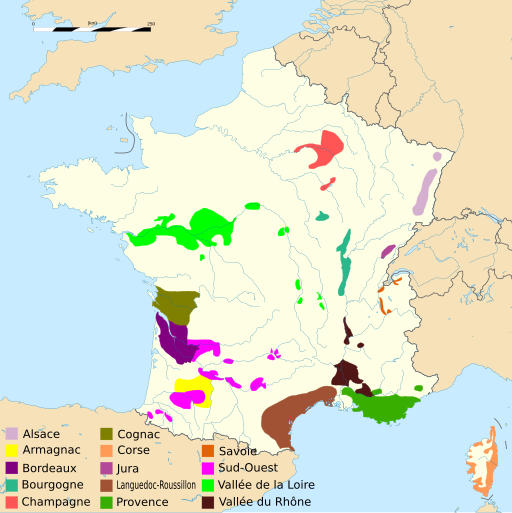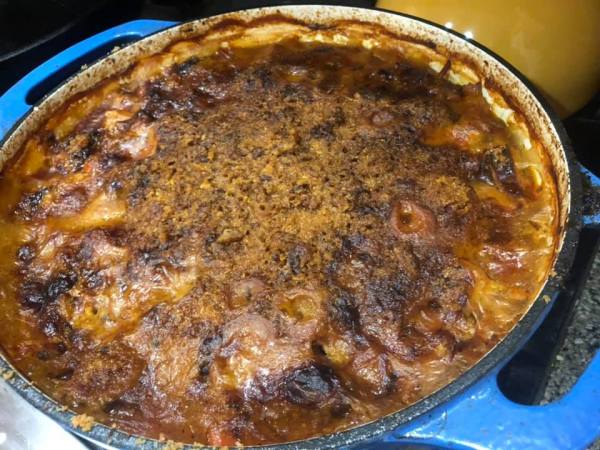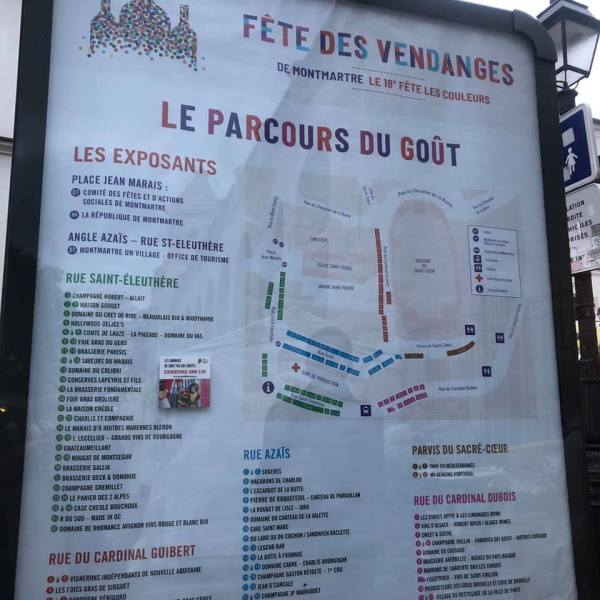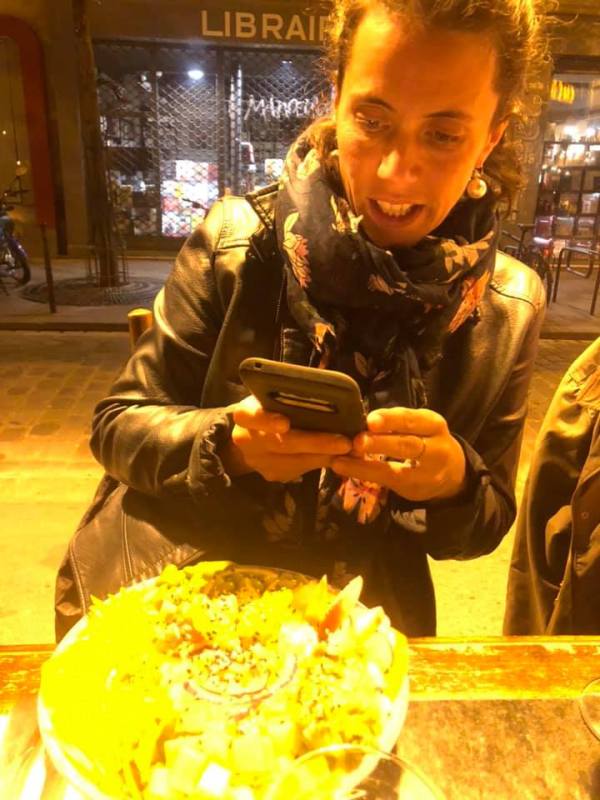
While wine grapes may be grown throughout the world, it is France that many consider the most important country for wine. Ever since the Greeks cultivated grapes in Gaul (France) in the 6th century, for over 2,000 years, growing grapes and making wine has been an important aspect of life in France. Wine grapes are grown throughout the country with 7-8 million bottles produced every year making France the number one producer of wine by volume in the world.
Did you know that most of the well-known grapes grown globally are actually French in origin? In France however, certain grapes are associated with particular areas generally because of climactic conditions– so much so that you may find it hard to determine what the grape or grapes might be in the bottle! For example, Cabernet Sauvignon is most famous from Bordeaux, Syrah in Rhône, Chardonnay in Bourgogne (including Chablis) and Champagne, and Sauvignon blanc in Loire and Bordeaux.
Since 2012, each bottle of French wine falls under one of these three classifications:
- Vin de France or basic table wine replaces the Vin de Table classification; grape variety allowed and vintage indicated on labels.
- Indication géographique protégée (IGP) replaces Vin de Pays.
- Appellation d’origine protégée (AOP) replaces AOC and is the highest or most exclusive classification; the first one was in the Rhone region of Châteauneuf-du-Pape.
While some say that France has 17 wine regions and others say 14 like the map below, some are more well known and significant than others, for example Alsace, Bordeaux, Burgundy, Champagne, Loire, Provence, and the Rhone.

In Châteauneuf-du-Pape more wine is made in this one area of the southern Rhône (large dark brown blob) than in all of the northern Rhône (small dark brown blob).

Châteauneuf-du-Pape in English means “The Pope’s new castle” because in 1308, that’s where Pope Clement V located his papacy and where the next Pope built his castle.
In 1923, the first AOC now AOP was formed to protect their name, and in 1954 the village of Châteauneuf-du-Pape banned flying saucers from flyings overhead, landing or taking off.
While there are 18 varieties of grape growing in CdP and wineries can make wine from any of them in any proportion, most of the reds lead with grenache, which is 71% of the plantings, followed by syrah at 10% and Mourvèdre at 7%.
“Yes, we blend!”
Because most French wines are meant to be enjoyed with food — meaning they aren’t typically cocktail or happy wines– they haven’t focused on making wines to drink on their own. This French style of wine making can be off-putting for some Americans who may also distrust the French funk that is common in many French wines which also dissipates when paired with food.

Châteauneuf-du-Pape is in the red region of the map of France.
On a cold winter day during a tumultuous flurry of events including getting laid off and having my dog hit by a car AND being on the eve of Cassoulet Day, there is nothing better than cassoulet — except when it is paired with special wine like Châteauneuf-du-Pape, special friends like Sue and the winemakers of Clos des Amis Bruce and Gretel, and a special occasion — like my birthday!
- Appetizers
Recipes from Chef Robin Goldstein, author of A Taste of Santa Barbara, and A Taste of Ojai cookbooks which we will be featuring on Sat. March 14
> Arugula wrapped with prosciutto drizzled with balsamic reduction
> Gorgonzola stuffed figs I used a St. Auger blue, figs instead of dates, toasted the walnuts first and warmed them in a 350 degree oven, so they were extra tasty
> Tapenade
> Goat Cheese Truffles variation: Sue used sun dried tomatoes from her garden instead of apricots, and toasted pecans instead of pistachios - Main meal course
Cassoulet (Sue went off of this recipe from Bon Appetite supplemented with boar sausage)
Warm French baguette from Fillmore’s Roan Mills
Spring greens - Dessert
Thinly sliced chocolate croissants
Organic dark chocolate bars
Cassoulet– a famous French peasant bean dish with duck, sausage, and sometimes rabbit, and is the ultimate comfort food.

Sue’s cassoulet with duck confit, boar and pork sausage, and pork shoulder ragu.
As we sat around sampling the wine, we shared our cassoulet stories. I tell my cassoulet story here in this post from a few years ago about when Sue agreed to make cassoulet for me for my birthday and how I came to have cassoulet the first time. It took her three days then and it took her three days this time too. Clearly, peasants had plenty of time to take foods that might not be so tender and tasty and make them so!
Gretel has a story about comforting cassoulet too. She and Bruce were heading to Casoumere in the South of France where Bruce had made connections with the artists and wine makers. Along the way, his relatives said the best oysters come from a town called Mez, so they stopped and Gretel wanted to put her feet in the Mediteranian Sea, so she walked out but slipped on algae and fell: “I can’t read the signs that tell me I should not go into the water. I go to the water and slip. Under the algae there are many razor sharp crustatians that have slit my foot. Bruce saw that I needed help so he finds the lifeguards who help me up and look at my foot. There are pieces of the mussel in there and I cannot get them out. A crowd is gathering and a woman comes out to look and brings out cognac in her skirts to make me feel better; I drank it of course! We go to the emergency room in the next town and wait and we wait, and no one is moving anywhere. I told Bruce I wanted to go and he obliged me. I wanted to go to castle.” Two hours later they arrived to beautiful charcuterie and a fantastic cassoulet that was so good, she no longer cared about the pain. “In the morning,” continues Gretel, “the woman who served us this wonderful meal called the local doctor to take out the pieces of mussel from my foot.”
In Bruce’s story, he related a trip to Europe when young. “Paris stank like shit,” said Bruce, “and I was appalled. Living on pate and baguettes, which was fine. We left Paris and went to the south of France. They have a beautiful castle which you could stay at as a youth hostel at the time. They served cassoulet and that meal changed everything. People were kind and nice other than the experience in Paris.” The castle and cassoulet changed everything on both trips and became the comfort both times… just like for me on this night in Bruce and Gretel’s castle in Santa Paula where we enjoyed Sue’s cassoulet and sampled wine together.

1999 – La Crau – Domaine du Dieux Telegraphe Châteauneuf-du-Pape
My friend Tony Fletcher brought this to me the first time he visited while he was on a book tour about six or so years ago when we also celebrated my birthday. I kept thinking I’d open it when he was visiting, but then we never did. It was a gift so I decided my birthday cassoulet dinner was the time to open and enjoy it.
La Crau is one of Châteauneuf-du-Pape’s most famous vineyards, and it is full of the stone called galets roulés, which maintain moisture in the soil and radiate heat at night to hasten ripening.
Color – Showing its age, an old dried out rose.
Nose – Definitely a bit of funk on the nose, roses, plums, cherries, baking spices, cloves, carnation, sandlewood, a bit of citrus as well, with food, the funk is a part of the richness of the food and wine together. Really important that the wine opens up to make it shine
Palate – Nice acidity, balanced tannins, this is a contemplative wine, complex, balanced, plums and cherries up front, rhubarb, root beer, sassafras on the finish, for Bruce there was a bit of tankiness, he wanted to decant it or let it hang out for a bit. Nice slately minerals on the finish as well. Silty, Down in the depths of your belly
Drinking this wine mad eye really that I had a whole different life 20 years ago when these grapes were harvested.
Pairing – Phenomenal with the provencal tapenade, so phenomenal that Sue noted that I commented “What a trip!” The garlic, herbs and salinity go so nicely with the earthiness of the wine. The herbs de provence of the goat cheese balls work perfectly also. Sue had a mini-orgasim when she tasted the pate and followed it up with a sip of wine. We agreed. Also perfect with the mushroom brie: put the two together and it is so wonderful by bringing out the bright tart cranberry characteristics in the wine. The wine and cassoulet are balanced together, and it all works but is not the best pairing. They don’t fight, but they just don’t add anything to enhance each other. It does however love the boar sausage in the dish.
“Yummy” was all Sue had to say…
Does the wine hold up to dessert? We paired it with a chocolate croissant, and found it works okay with dark chocolate and nuts, but Sue thinks a bit of dried fruit in the mix would make it better. Dark chocolate on its own works fine with the wine, bringing out a very tart fruit on the palate.

2013 – Clos De L’ Oratoire Des Papes Châteauneuf-du-Pape – 14.5% alcohol –
Color – Plum, transparent, mauve rose rim
Nose – Roses and carnation, pretty florals, I felt that it was very Grenache like.
Palate – Bruce said “It’s got some tannins”, and we agreed plus tart plum, plum skin, bright acidity with minerals on the back with black pepper, red licorice, raspberry, resonates in your chest, textural finish.
Pairing – Sue started off with the Provencal tepenade and was not disappointed. Herbs, garlic, salinity, bring out such nice fruit characteristics in the wine. So nice with the arugula wraps, the pepper characteristics of the arugula tame the pepper in the wine and highlight the fruit. Langres is also great, the funk of the rind brings out the fruit in the wine and tames the pepper qualities. With the cassoulet it is all about sasparilla and cola with the wine. So complex and enjoyable. A taste of black pepper in the meal, sets off the beautiful black pepper notes in the wine and brings out great fruity characteristics in the both of them.
For dessert does it work??? The chocolate crossant works well not too sweet, not to savory, not too rich. It works. With plain dark chocolate it is a bit too sweet for the wine. Dark chocolate with toasted nuts is a bit better, but the chocolate croissant with the wine is best of all.

2017 – Comte De Lauze Châteauneuf-du-Pape – 14.?%
We obtained this wine when we were in France on our Wine tasting championship when we met some fabulous friends, the greatest people to hang out with and experience the city of Paris. We wound up at a wine festival and met them there. When we came upon their tent, he handed us a bottle to enjoy, and here it is.
Color – Ruby red, fuchsia rim
Nose – Cranberry, pomegranate, bright fresh fruit, rhubarb the alcohol is present on the nose. Gretel felt that it was very much like a California wine.
Palate – Very tart fruit on the palate as well, raspberry, cherry, pomegranate, plum, plum skin, salinity on the back of the palate, very acidic.
Pairing – I’m not a fan of dates, so I had a bit of a hard time appreciating Sue’s dates stuffed with gorgonzola with toasted walnuts, but both Sue and Gretel were very happy with this pairing. The salinity of the tapanade works well with the wine taming down the fruit forwardness of the wine. The cassoulet works perfectly with the meal, especially the boar sausage and its garlic richness. There are so many layers of flavor that pair so well with the wine. What a terrific combination. When we were first tasting this wine, we did not know how well it would go with the meal. Bruce felt it should lay down a while, but with the rich meal it is perfect. Layers of flavor in both the wine and the food pair so nicely with the layers of flavor in the wine. This wine, the young fruity wine was really fantastic together. Not as great with dark chocolate and roasted nuts. Just stick with the dark chocolate. The chocolate croissant was perfect with the wine. Brioche and dark chocolate are the thing.
Photos of two memorable nights– at Gretel and Bruce’s home with cassoulet and running around Paris with Aurelie Delaissez-Forstallas and Michel Blanc.
We had met first in the Loire at a dinner the evening before the World Wine tasting Championship at Chateau Chambord, and when we realized we’d all be in Paris on Sunday night, we met up at the Fete des Vendanges (Festival of Vines) at Montmartre. We arrived during the final hour or so — what a great festival! Oysters, Champagne, and wines form around the world as well as beer and the FOOD!

It was unlike any other festival event I’ve attended. Not just the stunning location and fun friends, but the energy of the crowd was jovial, and it was FREE. If you wanted to taste, you bought a glass. If you wanted a glass of something, you purchased it– and it was affordable. You could also buy bottles to take home– and we bought beer as well as wine and Michel gifted us with the bottle we tasted this evening.
After the Festival, we went to the base of the cathedral where we sat down and shared a bottle of wine with fabulous views of the evening’s festivities (read more about the festival, the cathedral and the vines that grow in Paris here). Next we jumped on the Metro and arrived someplace for dinner. We ran around the city more until exhausted, we headed to our respective abodes. At some point, Michel gave in and gave me his vest which I proudly wear back home in the US.
Photos with me in them were taken by Sue Hill.
Join the French Winophiles on Sat. Jan. 18 at 8am Pacific for a twitter chat by following the hashtag #winophiles; chat questions follow. You can check out our posts on the topic of introducing a friend to French wine anytime!
- Robin at Crushed Grape Chronicles shares “French Wine…Where to Begin?”
- Pierre and Cynthia at Traveling Wine Profs share “Exploring French Wine on a Tight Budget at Trader Joe’s”
- Camilla at Culinary Adventures with Cam shares “Deciphering French Wine Labels”
- Wendy at A Day in the Life on the Farm shares “Mediterranean Shrimp with a Corsican Wine”
- Jill at L’Occasion shares “Your Ticket To French Wine Is Actually A Map“
- Nicole at Somm’s Table shares “French Wine 101 Cheat Sheet”
- Pinny at Chinese Food and Wine Pairings shares “Learn about Wines from the Bourgueil AOC While Eating Pork Tongue Head Cheese + Napa Cabbage Salad”
- Linda at My Full Wine Glass shares “One Name to Get You Started on French Wine”
- Jane at Always Ravenous shares “Discover French Wine: Where to Start”
- Gwen at Wine Predator shares two:
- “Introduce a Friend to French Wine 1: Chateauneuf – du – Pape and Cassoulet”
- “Introduce a Friend to French Wine 2: Loire’s Amirault in Nicholas Bourgeil”
- Susannah at Avvinare adds “Start Your French Wine Study With Beaujolais ”
- Terri at Our Good Life shares “Newcomer’s Guide to French Wine: the Burgundies“
- Jeff at Food Wine Click! shares “French Wine 101: Taste for Yourself”
Twitter chat topics and times:
- 11:00 am ET
Q1 Welcome to the 2020 kickoff for the French #winophiles. Where are you tweeting from? Introduce yourself, share a link to your blog. Visitors too! - 11:05 am ET
Q2 Today we’re challenging our group members to write a Newcomer’s Guide to French Wine. What would you do? A special wine? A list of wines? Highlight your approach! #winophiles - 11:10am ET
Q3 What are the keys to understanding French Wine? Are there unique qualities? #winophiles - 11:15am ET
Q4 Did you have an “aha” moment when it comes to French wine? Share your story! #winophiles - 11:20 am ET
Q5 What specific wine or wines did you suggest an interested newcomer to French wine? Tell us why you chose what you did. #winophiles - 11:25 am ET
Q6 Did price enter into your consideration for your recommendations? #winophiles - 11:30 am ET
Q7 Did you recommend wines from multiple regions or just one? Any reasoning? #winophiles - 11:35am ET
Q8 Did you suggest food pairings for your wine recommendations? #winophiles - 11:40am ET
Q9 Do you have favorite food pairings for French wines that might not have been in your post? (even non-French foods) #winophiles - 11:45am
Q10 If your friend wants to travel to France, would you send them to the region your suggested wines originate from? Why or why not? #winophiles - 11:50am
Q11 What next steps would you recommend to your friend, after they have taken your advice? #winophiles - 11:55am
Q12 Open comment time, any thoughts or discoveries you’d like to share? #winophiles - 12:00pm EDT
Thanks for joining our “Newcomers Guide to French Wine” at #winophiles! Join us in February as we share “Indigenous French Grapes / Godforsaken Grapes” with @Culinary_Cam!








Curious about the French #Winophiles?
In the fall, we determine the following years monthly prompts. We sample, review, pair, and write about these prompts and publish our results by 8am on the third Saturday of the month. We link to everyone’s posts so readers can find a lot of information on each topic!
Below you’ll see what we wrote about in 2019 and what we plan to do in 2020.
This is what we did for French #Winophiles:
- January 19, 2019: Biodynamic Wines of France
Host: Gwendolyn Alley, Wine Predator
Invite Post: Winophiles Go Biodynamic
Preview Post: Winophiles Investigate Biodynamic Wines of France
Post: Still and Sparkling: Two Biodynamic Wines from Alsace - February 16, 2019: Provence
Host: Wendy Klik, A Day In The Life On The Farm
Post: With Love from Provence: A Biodynamic Red and a Kosher Rose with Steak, Quiche, Salad - March 16, 2019: Women of Champagne
Host: Julia Coney, Julia Coney
Post: Wonderful Women of Champagne and Halibut 3 Ways - April 20, 2019: Chablis
Host: Liz Barrett, What’s In That Bottle?
Post: Chablis is … Chardonnay? Comparing 2 from France, 1 from CA Paired with Seafood Lasagna - May 18, 2019: Gérard Betrand Wines Languedoc- Roussillion
Host: L.M. Archer, L.M. Archer
Post: Bertrand’s Biodynamic Cigalus Paired with French Sausage - June 15, 2019: French Cheese & Wine
Host: Martin Redmond, ENOFYLZ Wine Blog
Post: Did Someone Say French Wine and Grilled Cheese? - July 20, 2019: Loire
Post: Off to Loire: Saumur-Champigny and Tritip Summer Salad - August 17, 2019: French Basque Country
Host: Lynn Gowdy, Savor the Harvest
Post: Madirin: French Basque Wine of Pyrenees with Pinxtos - September 21, 2019: Corsica
Host: Payal Vora, Keep the Peas
Post: Corsica Rose with Salmon Crespelle and Currant Clafoutis - October 19, 2019: Cahors
Host: Nicole Ruiz Hudson, Somm’s Table
Post: Organic Chateau du Cedre Malbec with French Charcouterie - November 16, 2019: Rasteau with Thanksgiving
Host: Michelle Williams, Rockin Red Blog
Post: Go Grenache Go Rasteau: 4 Paired with Lamb Daube - December 21, 2019: Vouvray
Host: Jeff Burrows, FoodWineClick
Post: Careme Organic Vouvray and Lunch at Chateau du Pray
What the French Winophiles plan to do in 2020:
- January 18: Newcomer’s Guide to French Wine
with Jeff Burrows of Food Wine Click - February 15: Indigenous French Grapes / Godforsaken Grapes
with Camilla M. Mann of Culinary Adventures with Camilla - March 14: Crémant de Bordeaux / Sparkling wine from Bordeaux
with Pinny Tam of Chinese Food and Wine Pairings - April 18: Northern Rhone
with Rupal Desai Shankar the Syrah Queen - May 16: Cru Beaujolais
with Cindy Lowe Rynning of Grape Experiences - June 20: “Unexpected Pleasures in Champagne– Still wines, biodynamic, or unusual grapes”
with us! - July 18: White Wines of Roussillon
with Lynn Gowdy of Savor the Harvest - August 15: TBA
with Jill Barth - September 19: Cotes du Rhone
with Michelle Williams of Rockin Red Blog - October 17: Jura
with David Crowley of Cooking Chat - November 21: TBA
with Linda Whipple - December 19: Burgundian-tied Wines of Oregon (or Champagne)
with LM Archer of LM Archer.








Interesting post. Looking forward to part 2.
LikeLiked by 1 person
Thank you!
LikeLike
I cannot think of anything more comforting than Cassoulet and Châteauneuf-du-Pape. You nailed it!
LikeLiked by 1 person
Thank you! What’s awesome is it’s a special occasion food AND a comfort food!
LikeLike
Whoa, 3 Chateauneuf-du-Pape’s. And cassoulet. THAT’s a birthday celebration!
LikeLiked by 1 person
Certainly memorable! and delicious!
LikeLike
Wow, I want to make a cassoulet now for my birthday. Châteauneuf-du-Pape…love how it sounds and tastes.
LikeLiked by 1 person
It is a lot of work but so tasty! I understand there’s an instant version that I’d like to test!
LikeLike
How to learn about French wine? Cook cassoulet and make some memories!
LikeLiked by 1 person
Very true!
LikeLike